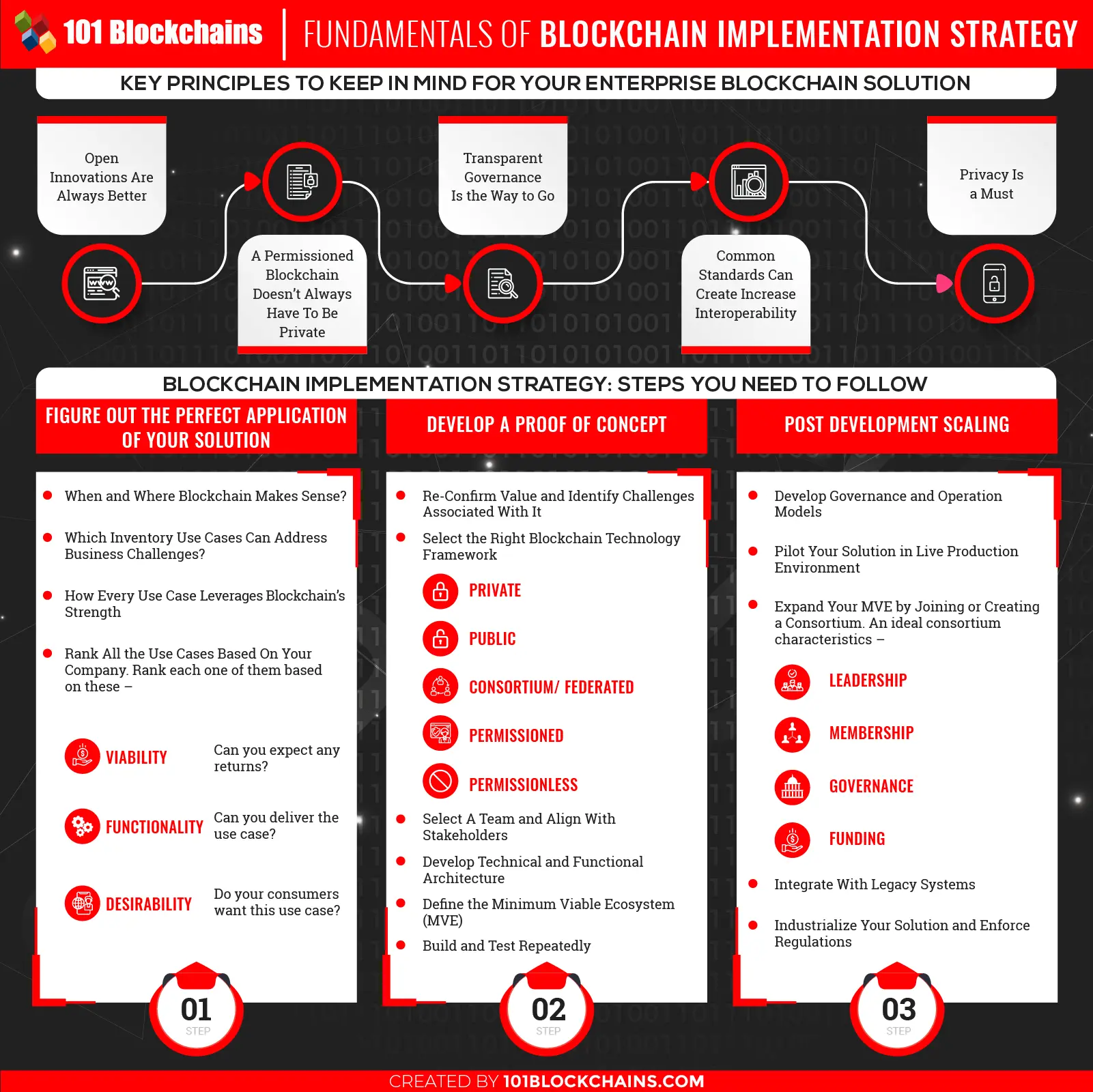Learn how blockchain truly works, master key definitions, and uncover what makes smart contracts so "smart." Dive into the fundamentals, gain valuable insights, and start your blockchain journey today!

- Blockchain
Hasib Anwar
- on October 10, 2021
Blockchain Implementation Strategy – Enterprise Framework [UPDATED]
Technology isn’t something that reaches saturation at any point. There are always new technologies being invented every single day, and each one is contributing to the modern tech world; we are all looking forward to it.
Like any other technology, blockchain has been making its way to the top revolutionary tech list at present. According to a recent survey, 53% of enterprises believe that blockchain technology is now a critical priority for their company.
However, there’s been a lot of experimentation regarding the tech. Anyhow, as the technology seems to be advancing more towards live projects, it’s better to learn about blockchain implementation strategy while you can.
So, to help you get on the blockchain race, we are offering a full-proof blockchain implementation strategy in this guide.
So, let’s begin!
Curious to learn about blockchain implementation and strategy for managing your blockchain projects? Enroll Now in Blockchain Technology – Implementation And Strategy Course!
Key Principles to Keep In Mind for Your Enterprise Blockchain Solution
Let’s start off with the basics before we jump into the blockchain implementation strategy. To make sure that your blockchain business process is successful, you should keep these enterprise blockchain points in mind. Let’s see what these are –
- Open Innovations Are Always Better
- A Permissioned Blockchain Doesn’t Always Have To Be Private
- Transparent Governance Is the Way to Go
- Common Standards Can Create Increase Interoperability
- Privacy Is a Must
Start your blockchain journey Now with the Enterprise Blockchains Fundamentals
Open Innovations Are Always Better
To ensure that your blockchain business process is open, you need to use the diverse community of open organizations and communities. In the long run, it will make sure that you always have quality codes.
Moreover, it would benefit you even more if you can be part of an open governance system that would foster under open licensing models. Also, if possible, you should avoid any kind of patented technology and use open-source frameworks that would offer sharing capabilities.
In reality, if you can do it properly, it would definitely increase your innovative skills and make your blockchain business process more lucrative. In parallel, you’ll be getting a decreased costing and time to make your blockchain strategy more mature.
For example, the Hyperledger blockchain enterprise project is actually under the Linux Foundation. In reality, developers consider it a greenhouse for offering enterprise-grade technologies and a diverse community of coders. At present, Hyperledger has 14 projects under its wings with three live ones.
Build your identity as a certified blockchain expert with 101 Blockchains’ Blockchain Certifications designed to provide enhanced career prospects.
A Permissioned Blockchain Doesn’t Always Have To Be Private
The second point to keep in mind is that all the enterprise-grade platforms have to deal with fiduciary and regulatory responsibilities. Thus, the blockchain business process needs to follow the principles of trusted access and permissioning.
Even though the public blockchain platforms does come with a lot of functionalities, still they aren’t suitable for enterprises. More specifically, those that revolve around regulations. In reality, all the organizations need to know who they are dealing with and also make sure that no one is using their platform for any illegal activities.
Therefore, a public blockchain doesn’t actually fit into the descriptions.
On the other hand, this doesn’t necessarily mean that you have to go with private blockchain only. Instead, you can leverage the facilities of permissioned platforms. Mainly these platforms are open for anyone to register, but they’ll need to verify their identity cryptographically.
If you can introduce a common identity standard, then it will be easy to streamline across different platforms with one set of verified credentials.
For example, Steller is a decentralized global payment system, and Sovrin is a digital identity management system. In reality, both of the platforms are open yet permissioned networks. On the other hand, TradeLens is also a permissioned system. It’s a supply chain management network that uses Hyperledger Fabric as the base technology.
Transparent Governance Is the Way to Go
Governance is something that people associate with corruption the most. Thus, if you want to make sure that your blockchain strategy platform can prevent any influences, then you need to go for transparent governance.
In reality, transparent governance can ensure a distributed and unique form of governance system that promotes trust without trusting.
Blockchain implementation companies should always consider platforms that will offer a democratic structure by default. Additionally, it needs to promote the permissioning options and privacy of the users as well.
On the other hand, there needs to be certain rules on who can join the networks, and how can they do it? Moreover, guidelines for specific role-playing in the system need to be specified form the start.
Anyhow, you need to distribute trust anchors across multiple parties because they tend to run the nodes and participate in the validation process. In reality, you’ll need at least three trusted anchors to make the governance model.
Additionally, the governance system should also maintain the financing model of the network. In reality, many solutions are financed with ledger operators or membership fees or a third party.
For example, in Canada, The Verified: Me is an identity network system. Here, SecureKey Inc. chooses Canadian banks as the trust anchors, and they would participate in validating transactions and hosting nodes.
As a result, they use a governance model that offers ongoing balances and checks between the constituent working groups.
Common Standards Can Create Increase Interoperability
You must follow this principle as it will future-proof your networks form the start. Moreover, it would also promote a robust ecosystem and prevent any kind of vendor lock-in situations. In the near future, it will all be about interoperability. So, using common standards to model your blockchain strategy would be an excellent idea.
Blockchain implementation companies should definitely consider this point. Even though most of the platforms are basically siloes, still the technology seems to be moving towards a model where it can support a network of networks.
So, to make sure your solution doesn’t fall behind, you need to keep common standards for a blockchain implementation strategy.
Additionally, the first step would be to have a registry of solutions. Additionally, all blockchain implementation companies should publish their data models and different policies. Also, whenever possible, use APIs that offer permissioned output or have a blockchain strategy on industry standards.
For example, Decentralized Identity Foundation offers a set of principles that would help you to identify digital assets, people, and organizations across multiple platforms. Many collaborative efforts such as Burrow of Enterprise Ethereum Alliance and Hyperledger fosters these principles.
Excited to learn the basic and advanced concepts of ethereum technology? Enroll Now in The Complete Ethereum Technology Course
Privacy Is a Must
Last but not least, keep in mind that privacy is a must. In reality, you’ll be distributing all of your user’s data across multiple nodes and sources. So, to make sure that they get full privacy, you need to offer control of who can see their data and who can’t.
Without this principle, blockchain implementation companies can’t promise any kind of privacy. Furthermore, as there isn’t a single user that would own any data that resides on its devices, only the creator would have a sole ownership claim on the data.
Moreover, APIs should extend this permissioned access automatically. Another thing to keep in mind is the regulations of GDPR. In many cases, it would mean you would have to keep all the personal data off-chain.
For example, in IBM Food Trust, the network allows participants such as Carrefour, Walmart, or Nestle to use the shared data to increase their food supply chain efficiency. On the other hand, it also keeps every member’s personal data off-limits.
Anyhow, now you know which principles to follow to make your enterprise blockchain implementation strategy a huge success. Let’s jump into the next segment, where we’ll discuss the steps of developing the perfect blockchain implementation strategy in the market. Let’s start!
Blockchain Implementation Strategy – Framework
Please include attribution to 101blockchains.com with this graphic. <a href='https://101blockchains.com/blockchain-infographics/'> <img src='https://101blockchains.com/wp-content/uploads/2019/10/blockchain-implementation-strategy.png' alt='blockchain implementation strategy='0' /> </a>
Blockchain Implementation Strategy: Steps You Need To Follow
There are various ways where you can come up with the perfect blockchain implementation strategy. However, we’ll use a path that would help out greatly. Let’s see these blockchain implementation steps –
Step-1: Figure Out the Perfect Application of Your Solution
When and Where Blockchain Makes Sense?
Well, for starters, you need to learn about blockchain. The more you’ll learn about it, the more you’ll know how it works and where you can use it. In reality, blockchain in every aspect of your company might not make any sense. So, specify where you can leverage blockchain.
It will definitely help to build up the next phases of your blockchain implementation strategy.
Which Inventory Use Cases Can Address Business Challenges?
Here, you need to see the blockchain impact on business. Basically, you’ll be figuring out which use cases of blockchain can address any specific business problem. In reality, there are issues when it comes to businesses.
Usually, they don’t have transparency, they are full of corruption, they lack privacy, and they have security loopholes. Additionally, there are many more challenges to overcome, as well. So, address the challenges and make which uses cases can solve them.
Wanto to learn more about enterprise blockchain implementation? Read More for the Top 10 Enterprise Blockchain Implementation Challenges
How Every Use Case Leverages Blockchain’s Strength
Another point that would help you estimate blockchain impact on business is assessing how each use cases leverages blockchain’s strengths. Obviously, not every single-use cases would use all the features of blockchain.
In reality, some might use transparency, some can use distributed nature, some can use security protocols, and so on. Anyhow, this step would definitely let you know about the blockchain impact on business.
Rank All the Use Cases Based On Your Company
Now it’s time to rank all the use cases based on your company. As every company is geared towards a specific industry, you’ll be focusing on something that you can leverage. For example, if you are a manufacturing company, you should focus on tracking and traceability rather than a certification or revenue sharing.
To rank them, use these three principles to help you out –
- Viability: Well, you’ll need to see whether you can expect a return for a use case.
- Functionality: Here, you have to assess whether you can deliver the use case or not. Additionally, make sure that you are aligned with your resources and blockchain investment strategy.
- Desirability: Along with the previous two, try to focus on the use cases that your consumer desires. If you focus on an undesirable solution, you won’t get a proper response from your customers. So, your blockchain investment strategy would be a complete waste.
Top Blockchain Use Cases Trending in 2019
While you are ranking and listing the blockchain use cases that you should prioritize, you should check out the market out there.
A 2019 Survey on 1386 global enterprises might help you out in figuring the perfect blockchain implementation strategy for you. However, you should understand that the survey isn’t speaking for all the companies using the blockchain technology. So, the “true” numbers may vary. For more information checkout the survey from here.
The following table would help you understand the concept better –
| Sl. No. | Use Cases | Percentage of Enterprises Focusing on It |
| 1 | Data Validation | 43% |
| 2 | Data Access or Sharing | 40% |
| 3 | ID Protection | 39% |
| 4 | Payments | 37% |
| 5 | Digital Currency | 36% |
| 6 | Track and Trace | 32% |
| 7 | Certification | 30% |
| 8 | Access to Intellectual Property | 30% |
| 9 | Record Reconciliation | 25% |
| 10 | Asset Transfer | 24% |
| 11 | Revenue Sharing | 23% |
| 12 | Asset-backed Tokens | 22% |
| 13 | Tokenized Equity | 21% |
| 14 | Tokenized Asset | 20% |
| 15 | Time Stamping | 19% |
| 16 | Custody | 16% |
| 17 | Others | 2% |
Let’s move on to the next step of the blockchain implementation strategy.
Start learning Blockchain with World’s first Blockchain Skill Paths with quality resources tailored by industry experts Now!
Step-2: Develop a Proof of Concept
Re-Confirm Value and Identify Challenges Associated With It
To be in perfect sync with your blockchain investment strategy, you need to re-evaluate the use cases you selected. In reality, make sure you also consider the challenges in blockchain implementation. In any case, you need to understand if the challenges are too much for your blockchain investment strategy.
If it poses a lot of challenges, then it’s best to skip it. Go with the use cases that come with fewer challenges and more benefits.
Select the Right Blockchain Technology Framework
This is one of the major points where you need to be absolutely right. There are various blockchain frameworks on the market right now. Moreover, you need to figure out which type of framework would be suitable for your company.
For instance, there are enterprises that use a private blockchain. On the other hand, many enterprises also use public ones as well. So, pick out the best type that goes with the solution and your company standards.
Blockchain Models
There is no cookie-cutter blockchain model or architecture that you can follow while designing your organizational structure. Each of the models has its own perks and downsides. So, the final decision is totally up to you.
As we are talking about this issue, you should check out the popularity of the blockchain business models that most of the rising companies are focusing on this year. Take a look at a table below –
| Sl. No. | Blockchain Model | Percentage of Enterprises Focusing on It |
| 1 | Private | 50% |
| 2 | Permissioned | 45% |
| 3 | Public | 45% |
| 4 | Consortium or Federated | 29% |
Curious to learn how business model innovation can support the growth of your business? Join the Standard & Premium Plans and Enroll Now in Business Model Innovation Course!
Select A Team and Align With Stakeholders
Now you know just what to do in your blockchain implementation strategy. Next, blockchain development companies should pick the right people to make an excellent team. Keep in mind that it will all come down to how your team approaches the solution.
By any chance, if your team members aren’t fully exposed to the concept of blockchain, teach them. Additionally, blockchain development companies should offer training sessions for this as well.
Also, select your developers correctly as there aren’t many people skilled in the coding blockchain.
Once you have your team ready, explain your primary strategy with your stakeholder, and keep them aligned.
Develop Technical and Functional Architecture
After you’ve selected the framework type, you’ll be working with start building your technical and functional architecture. In reality, this part is fairly technical, and you’d need to use your developers to program the solution.
But remember not to jump into adding functionalities before you can properly structure a functioning model. Anything you build on a weak base would not work the way you intended. Also, don’t get greedy, keep things minimum, and add the functions you only need.
Define the Minimum Viable Ecosystem (MVE)
After you are done with the architecture, it’s time for you to define the Minimum Viable Ecosystem (MVE). All the blockchain development companies should consider this because it will help to generate value from any solution or products more.
It will also help to scale your system when needed.
Build and Test Repeatedly
All is done. Now, complete the developing process and test out your solution. In reality, blockchain development companies need to test out the finished product over and over before rolling it out. Furthermore, by doing it repeatedly, you can find any loopholes or flaws in the code. So, it’s a major point for your blockchain implementation strategy.
Aspiring to make a lucrative career as a blockchain developer but not sure how? Check the detailed guide Now on How To Become Blockchain Developer?
Step-3: Post Development Scaling
This step is mostly for giving you a long-tern blockchain implementation strategy. After you have rolled out your solution, you would have to have the blockchain implementation strategy for the long term as well or else you’ll fall behind the competition.
Develop Governance and Operation Models
Start developing your governance model and other operational models to scale up. In reality, governance models will play a huge role in your blockchain implementation strategy – especially for enterprises.
Pilot Your Solution in Live Production Environment
You can also pilot your solutions in live production environments. It will give you a steady stream of revenue and would boost your company’s efficiency rates.
Expand Your MVE by Joining or Creating a Consortium
The best way to scale up is to create or join a consortium. In reality, consortiums promote a collaborative environment and offer a lot of benefits. Additionally, you can get access to any features other companies might use that could be beneficial for your blockchain implementation strategy as well.
To make your consortium a success offer these factors –
- Leadership
- Membership
- Governance
- Funding
Integrate With Legacy Systems
Also, start to integrate your blockchain solution with legacy systems. Here, the more you can offer a stable integration, the more value your solution would get. Additionally, it would also ensure that your product works efficiently without any issues. So, it’s also a major point of the blockchain implementation strategy.
Industrialize Your Solution and Enforce Regulations
Enforce regulations to secure your solution and also start to industrialize. Basically, you’ll roll out your solution as an industrial product. Thus, your consumers can use that solution without changing anything and get readymade blockchain products at their expense.
There are so many IT aspirants who don’t know the relation between Blockchain and Data Privacy and if you’re also one among them, then you must enroll in Blockchain and Data Privacy Masterclass Course now!
Last Thoughts
Blockchain technology has already started to disrupt some industries, and this will continue in the future as well. So, before your enterprise becomes obsolete, you should develop your blockchain implementation strategy as soon as possible.
We’ve given you a complete package to help you get your blockchain implementation strategy started. So, don’t waste any more time and start strategizing now!
*Disclaimer: The article should not be taken as, and is not intended to provide any investment advice. Claims made in this article do not constitute investment advice and should not be taken as such. 101 Blockchains shall not be responsible for any loss sustained by any person who relies on this article. Do your own research!







